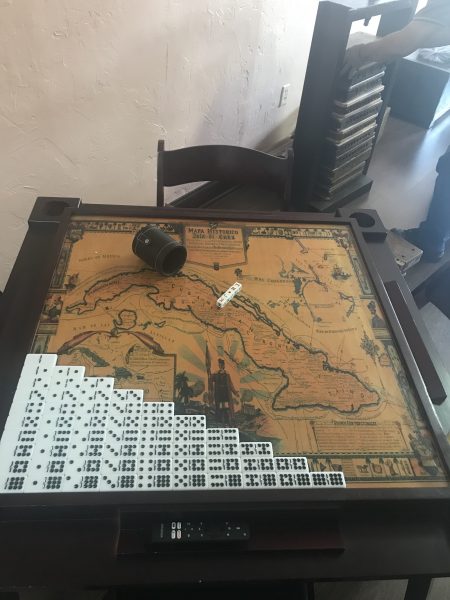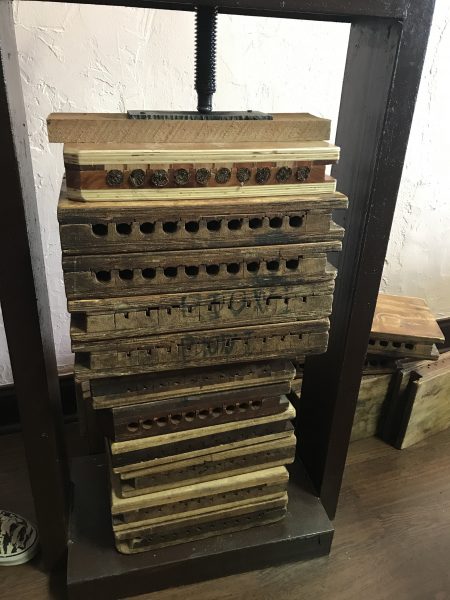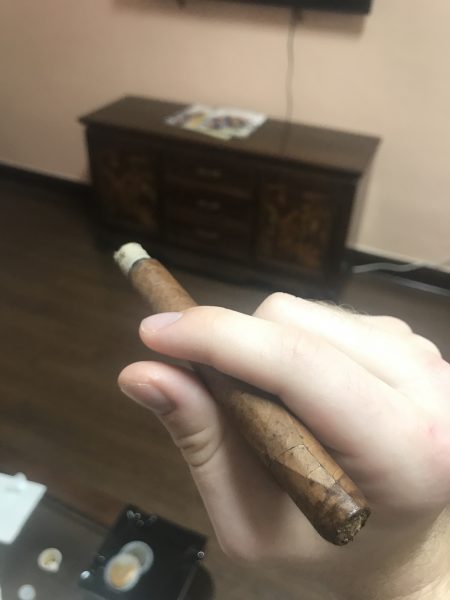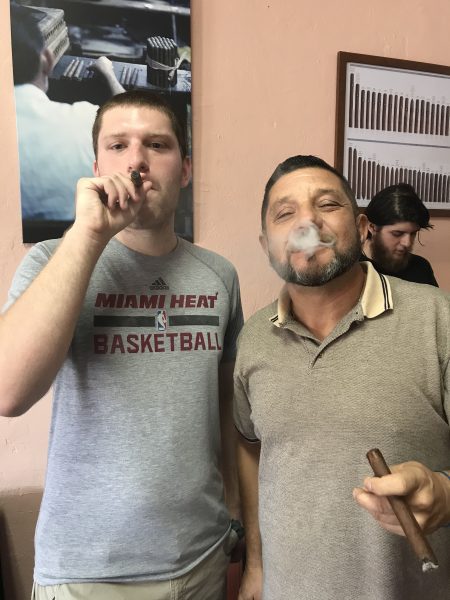Posted November 20, 2019
By AUSTIN PERT
I use my fingers to grip the perfectly rolled cigar like I’m about to write with a pencil. I put the thrice-rolled leaves into my mouth and start to inhale, taking in the smoky aroma of the thick stick until I take it out of my mouth and exhale, releasing a puff cloud of smoke. So much went into making that cigar, and any other cigars sold along Miami’s famous Calle Ocho in Little Havana.
“It’s both an art and a science,” Renne Diaz, the establishment’s owner, tells me.
Diaz is a Chilean immigrant who has been in the U.S. for over two decades and has settled in Miami via an initial stop in New Jersey.

I sit in Little Havana’s Casa de Tabaco, located in the heart of the highly caffeinated SW 8th Street, better known as Calle Ocho. Here, a separate party of four and I sit and learn about the cigar making process before enjoying a sample on the house.
In a town full of beaches, nightclubs and other distractions, few things authentically represent Miami than a satisfying cigar.
The shop I enter is a modest one, not over the top, but certainly sufficiently well maintained. Patrons will immediately notice the smell of the tobacco and murals of the Cuban countryside hung on the walls.
The hour-long demonstration begins in the back of the store, where us guests are greeted with Cuban snacks and cafecito. A shot or four of coffee gets things started right, along with a sweet guava pastry. Around now, Diaz begins to play a video, walking us through the tobacco and cigar making process.
The first thing he tells us is that despite the term “Cuban cigar,” the cigars we will try are actually from the Dominican Republic and Nicaragua. This is because of the United States government’s lasting embargo on goods and services from Cuba, including their famous tobacco. “Any true Cuban cigar would be contraband in the U.S.,” Diaz says with disappointment.

Those hoping for a “real” Cuban cigar will have experienced some disappointment by now, but we are assured that the tobacco we’ll try very closely resembles the authentic material on the island.
Diaz’s son, who also goes by the name of Renne and was born in Miami, begins to explain the botanic side of tobacco growing, stressing the importance of good, rich soil to make way for the plant.
The video we watch explains the “science” part of cigars, showing seed being layered on the rich, tropical soil. The soil and the seed on top then grow as the season progresses. When the tobacco leaves are finished growing in late summer and early fall, the leaves are taken to a greenhouse or barn where temperature and humidity can be controlled.
Here, leaves sit and dry in a process known as air curing. When the leaves enter the barn after being harvested, they are green, but turn brown as the moisture is dried from the leaves.
This process lasts for six weeks to two months. Once finished, the tobacco leaves are very dry and brown, and ready for the next step in the cigar making process.
Once the tobacco leaves have been grown, harvested, and cured, the next step is turning the processed leaves into ready-to-smoke cigars. Diaz says that if tobacco farming is a science, then cigar rolling is an art.
But both sides are very active and labor-intensive. Throughout the history of civilization in the Americas, tobacco has always been a high-demand commodity for the wealthy which has led to exploitation of workers, from American slave labor all the way to Cuba’s Castro regime.
“Sometimes a true Cuban cigar is disappointing,” says Diaz. “Cigars require very deliberate and delicate attention to detail, and when an average Cuban worker is making cigars just to survive, the overall quality of the product can be very average.”
All of us listening have to ponder that statement for a moment. But as Diaz demonstrates for us, we realize how much effort is truly required.

When rolling the tobacco leaves into a smoke-worthy cigar, laborers must follow a three-step process. Diaz walks us through these three steps by taking three leaves, with each of them forming one layer in the three-layer cigar. Each of these leaves must be carefully rolled in order for the cigar to be useable.
Starting with the filler–which acts as the cigar’s inner core–this layer is tightly pressed in order to ensure the cigar’s foundational strength. The binder is rolled next and forms the middle layer of the cigar. Next, Diaz rolls the wrapper, which forms the outside the cigar and is the chief layer.
In addition to being the only visible layer to the consumer, “the wrapper provides all the flavor and aroma of the cigar for the smoker.”
When we sniff each of the three types of leaves–representing the three layers of the cigar—the leaves that are set to be rolled into wrappers have by far the strongest smell and flavor.
In the front of the shop, a woman by the name of Aleida sits by the window, rolling cigars and people watching the exterior sidewalk. Her knowledge and experience in cigars is interminable, having lived in Cuba for the first five decades of her life.
Fifteen years ago, she migrated from Cuba to the Canary Islands, and has lived in Miami for the past five years. She talks to us in Spanish, and uses Diaz to translate for us.

Once the cigars are done being rolled, they must be placed in the presser. Diaz demonstrates as he places each symmetrical, perfectly rolled cigar in this tall, wooden contraption. Here, the cigars are pressed for roughly 45 minutes, and come out ready to either sell or smoke.
For us, we are here to smoke. Each of us are given one free cigar, which for me, is my first cigar ever.
As I light the cigar, I naturally get skittish as a literal spark engulfs the cigar’s interior. But this is the grand finale and I need to embrace this head on. I place the cylindrical cigar in my mouth, move my lips and tongue around, and just control my breathing.
My mouth burns, and I’m taken somewhat by surprise by the whole sensation. The smoke causes me to cough a couple of times, so I have to take the cigar out of my mouth for a moment. But the flavor is the most unique part, and sums up the entire experience. So much history has revolved around this taste, this aroma, this sensation.
Centuries of world trade revolved around this commodity, has been a motivation behind wars, military coups, and involuntary servitude. As I finish the cigar, and drink some water to refresh my now dry mouth, I think back to every historical development surrounding the cigar. Very little has changed in these hundreds of years; the cigar and the manufacturing process is still entirely manual, and will remain so for the foreseeable future.
If You Go
Casa de Tabaco
1743 SW 8th St., Miami, FL 33135.
Telephone: 786-360-4952.
